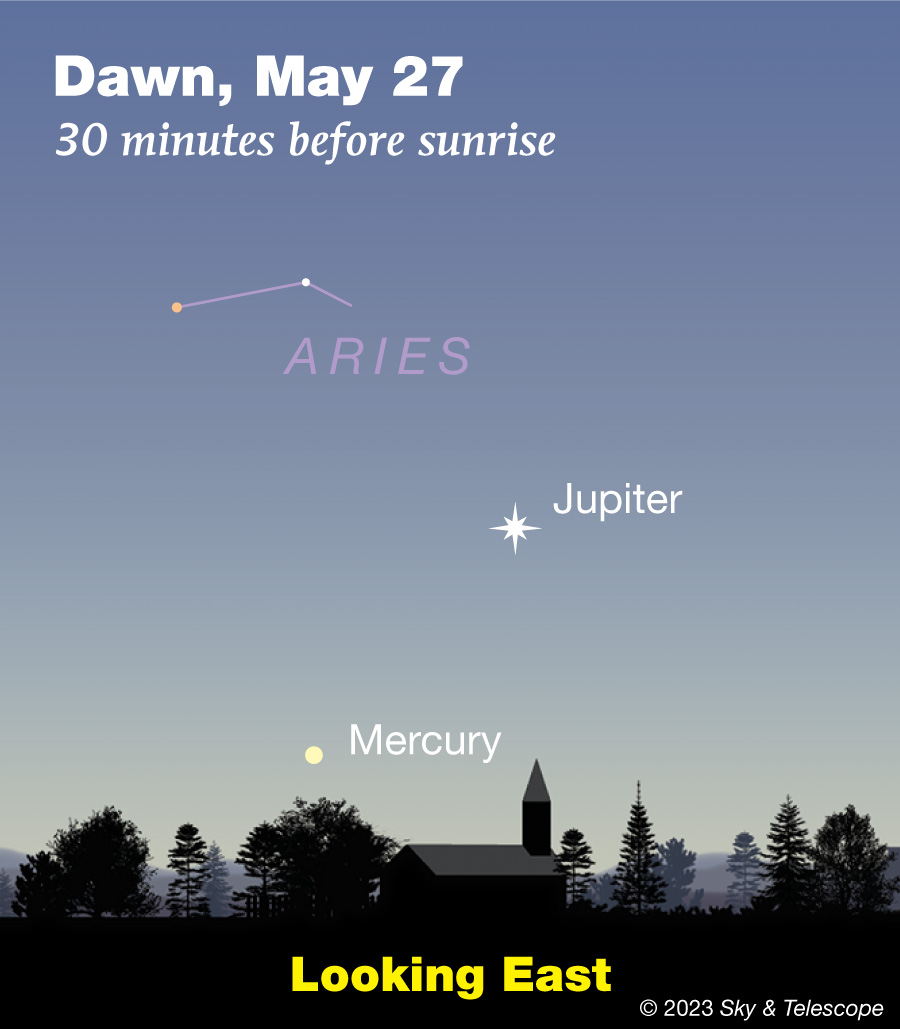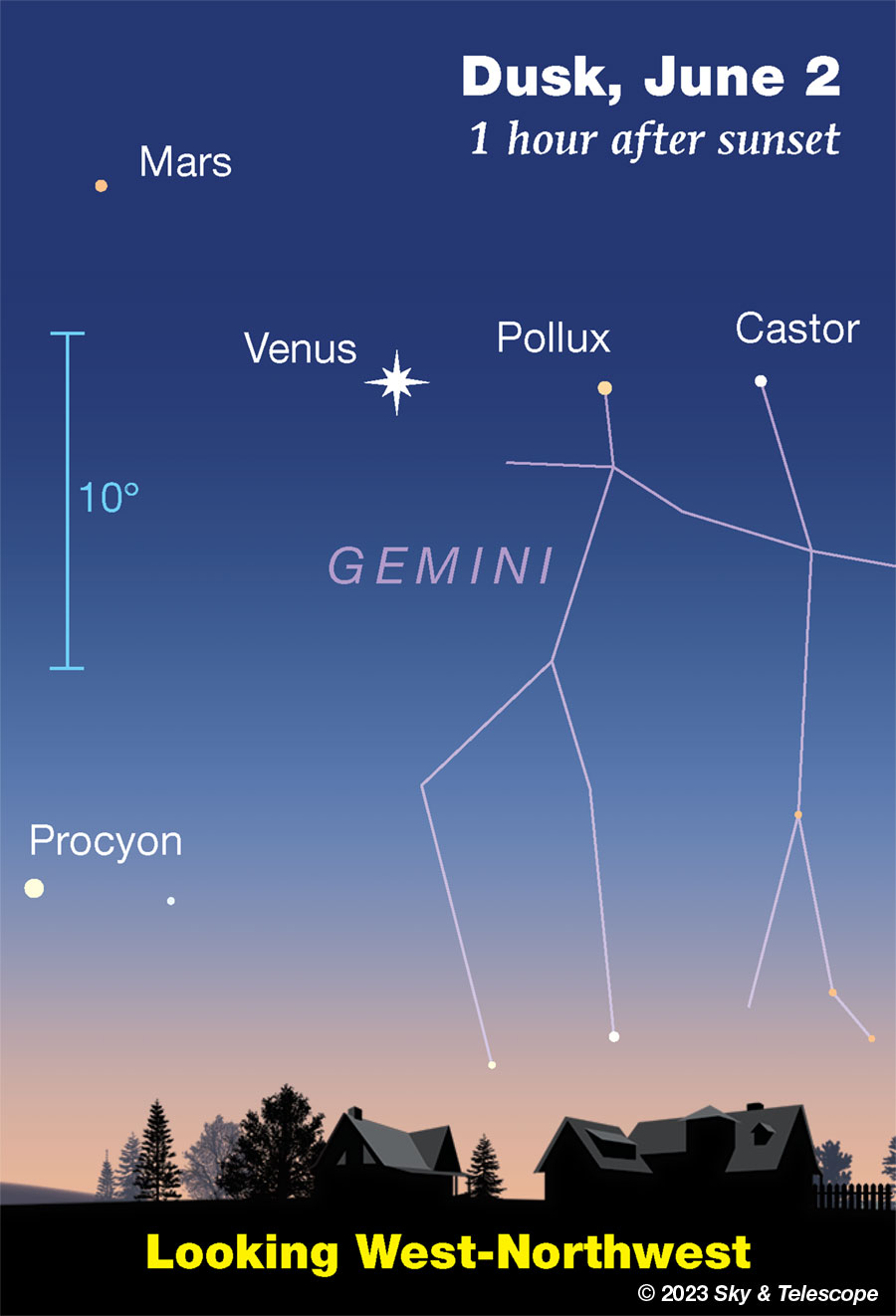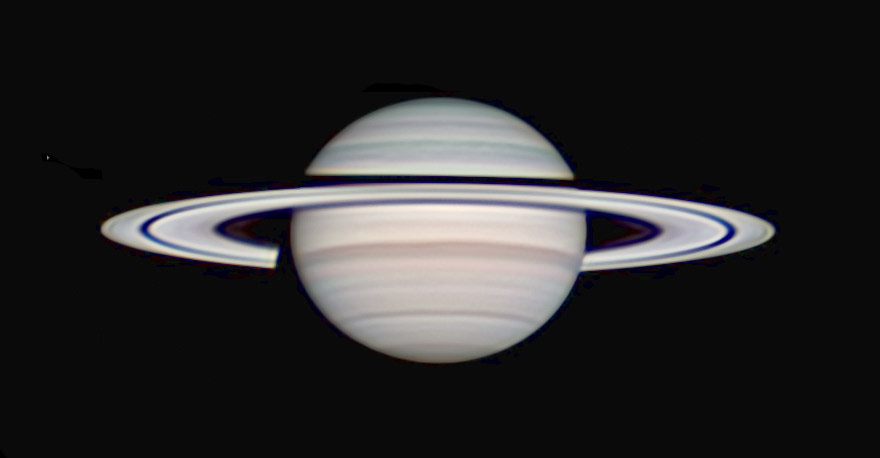Supernova in the Pinwheel Galaxy, update May 28th: SN 2023ixf continues to hold at about magnitude 11.0, where it has been since May 23rd following its discovery at mag 14.9 on May 19th.
But unfortunately the Moon is getting bright. This evening, using my 12.5-inch reflector at 75×, I identified the supernova itself at precisely the right spot using the good charts in the article linked below. But the moonlight and the slight haze of the humid night made the huge, low-surface-brightness glow of M101 almost undetectable. I doubt that a smaller scope would have worked for M101 at all in these conditions. Still, it was amazing to see an individual star, looking like any other faint white star in the eyepiece, at a distance of 21 million light-years.
The moonlight will get worse for about the next week. Then on June 5th or 6th a window of moonless darkness starts opening between the end of twilight and moonrise.
Supernovae usually stay bright for weeks, and there's no telling what this one may do next. See our article Bright Supernova Blazes in M101, the Pinwheel Galaxy (with those charts).
FRIDAY, MAY 26
■ The Moon, very nearly first quarter, shines in the Sickle of Leo after dusk. It's almost between the Sickle's two brightest stars: Regulus lower left of the Moon, and fainter Gamma Leonis (Algieba) to the Moon's upper right.
■ Have you ever seen Alpha Centauri? At declination –61° our brilliant, magnitude-zero neighbor is permanently out of sight if you're north of latitude 29°. But if you're at the latitude of San Antonio, Orlando, or points south, Alpha Cen skims just above your true southern horizon for a little while late these evenings.
When does this happen? Just about when Alpha Librae, the lower-right of Libra's two brightest stars, stands due south over your landscape. At that time, drop your gaze straight down from Alpha Lib toward Alpha Cen.
SATURDAY, MAY 27
■ First-quarter Moon (exact at 11:22 a.m. on this date EDT). Come evening the Moon shines under Leo's midsection. It's not quite halfway from Regulus, Leo's forefoot lower right of the Moon, to Beta Leonis or Denebola, the Lion's tailtip to the Moon's upper left.

SUNDAY, MAY 28
■ Venus passes its closest to Pollux tonight and tomorrow. They're 4° apart, with Pollux to Venus's upper right.
■ Bright Capella sets low in the northwest fairly soon after dark these evenings (depending on your latitude). That leaves Vega and Arcturus as the brightest stars in the evening sky.
Vega shines in the east-northeast. Arcturus is way up very high toward the south.
A third of the way from Arcturus to Vega, look for semicircular Corona Borealis, the Northern Crown, with 2nd-magnitude Alphecca as its one moderately bright star. It's the jewel on the front of the tiara.
Two thirds of the way from Arcturus to Vega is the dim Keystone of Hercules, now lying almost level. Use binoculars or a telescope to examine the Keystone's top edge. A third of the way from its left end to the right is 6th-magnitude M13, one of Hercules's two great globular star clusters. In binoculars it's a tiny glowing cotton ball. A 4- or 6-inch scope begins to resolve some of its speckliness. Located 22,000 light-years away far above the plane of the Milky Way, it consists of several hundred thousand stars in a swarm about 140 light-years wide.
MONDAY, MAY 29
■ Bright Arcturus shines pale yellow-orange high overhead toward the south these evenings. The kite shape of Bootes, its constellation, extends up from Arcturus as you face south. The kite is narrow, slightly bent to the right, and 23° long: about two fists at arm's length. Corona Borealis is just east (left) of the Bootes kite.
TUESDAY, MAY 30
■ "Cassiopeia" usually means "Cold!" Late fall and winter are when this landmark constellation stands high overhead after dark (seen from mid-northern latitudes). But even on these warm evenings, it still lurks low. As twilight fades out, look for it down near the north horizon: a wide, upright W. The farther north you are the higher it'll appear, but even as far south as San Diego and Atlanta it's completely above the horizon.
WEDNESDAY MAY 31
■ Constellations seem to twist around fast when they pass your zenith — if you're comparing them to the direction "down." Just a week and a half ago, the Big Dipper floated horizontally in late twilight an hour after sunset (as seen from 40° N latitude). Now it's angled diagonally at that time. It will be hanging straight down in just another week and a half!
THURSDAY, JUNE 1
■ Two weeks ago Mars lined up left of Pollux and Castor. This evening and tomorrow evening it's Venus's turn, as shown below.

Mars up over there looks forlorn. But it's putting on a performance of its own. . . .
FRIDAY, JUNE 2
■ After dark Mars shines inside the Beehive cluster, M44, near the central beehive-shaped asterism itself (which is currently tilted right). Use binocs or, better, a telescope.
Mars is moving east across the cluster at about 90 arcseconds per hour. Can you see its position change with respect to the stars in as little as a half hour? Note the shape it makes with the closest faint stars to it that you can see, as noted in the June Sky & Telescope, page 49.
Venus will follow in Mars's footsteps past the Beehive on June 12th and 13th.
SATURDAY, JUNE 3
■ Full Moon (exact at 11:43 p.m. EDT). Look for orange Antares just 3° or 4° to the Moon's upper right this evening. Binoculars will help pull Antares out of the bright moonglare.
And upper right of Antares by 7½° is Delta Scorpii, about half as bright but less blasted by moonlight. Delta Sco is the middle, and brightest, of the three stars forming the head of Scorpius. Use those binocs.
SUNDAY, JUNE 4
■ Vega is the brightest star in the east-northeast after dark. Look 14° (about a fist and a half at arm's length) to Vega's upper left for Eltanin, the 2nd-magnitude nose of Draco the Dragon. Closer above and upper left of Eltanin are the three fainter stars forming the rest of Draco's stick-figure head, also called the Lozenge; the faintest of them is 4th magnitude. Draco always points his nose to Vega.
This Week's Planet Roundup
Mercury is deep in the glow of sunrise. You can use binoculars to try for it 10° or 12° (about a fist at arm's length) lower left of brighter Jupiter.
Venus (magnitude –4.4, in Gemini) is the brilliant "Evening Star" in the west-northwest from twilight into late evening. It still shines high in the dusk, and it doesn't set until about 2 hours after dark.
Venus shines below Pollux on May 26th, then it lines up with Castor and Pollux on June 1st, straight to their left. That's where Mars was just two weeks ago.
In a telescope Venus is a dazzling little half-Moon shape, about 50% sunlit and 22 arcseconds in diameter. It enlarges a little every day while waning in phase. It will become a bigger, thinning crescent dropping low from mid-June through mid-July.
Mars (magnitude 1.6, in Cancer) glows weakly to the upper left of Venus by an ever-shrinking distance: 13° on the evening of May 26th, 10° by June 2nd. That's about a fist at arm's length.
But no conjunction is in store. Mars and Venus will reach a minimum separation of 3.6° on June 30th, then they'll start to draw apart again as Venus plunges down toward the sunset. This is called a quasi-conjunction, because they don't pass each other although they do get within 5° of each other.
In a telescope Mars is just a tiny blob 5 arcseconds in diameter. Don't be too disappointed.
Jupiter (magnitude –2.1, in Aries) is emerging from the bright glow of sunrise. Look for it low in the east about 40 minutes before sunup.
Saturn (magnitude +1.0, in dim Aquarius) is fairly well up in the southeast at the beginning of dawn.

Also notice the black on each side of the rings where they cross the planet's disk. The dark black south of (above) the rings is their shadow on the globe. The thinner, slightly grayer black to their north is the dim, sparse inner C ring, seen in front of the planet's bright face.
Uranus, magnitude 5.9, is hidden low in the sunrise.
Neptune is still too low in the east before dawn begins.
All descriptions that relate to your horizon — including the words up, down, right, and left — are written for the world's mid-northern latitudes. Descriptions and graphics that also depend on longitude (mainly Moon positions) are for North America.
Eastern Daylight Time (EDT) is Universal Time minus 4 hours. UT is sometimes called UTC, GMT, or Z time.
Want to become a better astronomer? Learn your way around the constellations. They're the key to locating everything fainter and deeper to hunt with binoculars or a telescope.
This is an outdoor nature hobby. For a more detailed constellation guide covering the whole evening sky, use the big monthly map in the center of each issue of Sky & Telescope, the essential magazine of astronomy.
Once you get a telescope, to put it to good use you'll need a much more detailed, large-scale sky atlas (set of charts). The basic standard is the Pocket Sky Atlas (in either the original or Jumbo Edition), which shows all stars to magnitude 7.6.

Next up is the larger and deeper Sky Atlas 2000.0, plotting stars to magnitude 8.5; nearly three times as many. The next up, once you know your way around, are the even larger Interstellarum atlas (stars to magnitude 9.5) or Uranometria 2000.0 (stars to mag 9.75). And be sure to read How to Use a Star Chart with a Telescope. It applies just as much to charts on your phone or tablet as to charts on paper.
You'll also want a good deep-sky guidebook. A beloved old classic is the three-volume Burnham's Celestial Handbook. An impressive more modern one is the big Night Sky Observer's Guide set (2+ volumes) by Kepple and Sanner.
Can a computerized telescope replace charts? Not for beginners, I don't think, and not on mounts and tripods that are less than top-quality mechanically. And as Terence Dickinson and Alan Dyer say in their Backyard Astronomer's Guide, "A full appreciation of the universe cannot come without developing the skills to find things in the sky and understanding how the sky works. This knowledge comes only by spending time under the stars with star maps in hand."
![]() Audio sky tour. Out under the evening sky with your
Audio sky tour. Out under the evening sky with your
earbuds in place, listen to Kelly Beatty's monthly
podcast tour of the heavens above. It's free.
"The dangers of not thinking clearly are much greater now than ever before. It's not that there's something new in our way of thinking, it's that credulous and confused thinking can be much more lethal in ways it was never before."
— Carl Sagan, 1996
"Facts are stubborn things."
— John Adams, 1770
 3
3









Comments
Rod
May 26, 2023 at 10:37 am
This morning, I did some solar observations.
Observed 0900-1000 EDT/1300-1400 UT. 6 active region sunspots reported today by spaceweather.com, and https://soho.nascom.nasa.gov/sunspots/
I used my 90-mm refractor telescope with glass white light solar filter for safe viewing. Power ranged 25x to 53x using TeleVue and Orion eyepieces along with #12 yellow filter. Various lighter plage areas visible along with some larger than earth size sunspot regions like AR3310 and even larger areas like AR3315. Dark cores visible along with lighter areas around the cores. Spaceweather.com reported this morning, "GLANCING-BLOW CME POSSIBLE TODAY: NOAA forecasters say that a CME might pass near Earth (or maybe deliver a glancing blow) today, May 26th. It was hurled into space four days ago by an M1.9-class flare from sunspot complex AR3311-12. At most, minor G1-class geomagnetic storms could result from the close encounter." I could see AR3311 and AR3312. Fun solar observing this morning. The Sun reported by Stellarium 1.013 au. My telescope views resolved ~ 5.7 arcsecond so about 4188 km diameter on the Sun. Earth size about 17.5 arcseconds. AR3310 and AR3315 are much larger in size. High cirrus passed, winds aloft over my area 30,000 250/58 knots. Temperature 17C, enjoyable time outdoors this morning.
You must be logged in to post a comment.
mary beth
May 29, 2023 at 12:22 pm
Nice report Rod! Very good you have all the equipment for safe solar viewing. Since you always put the temperature in Celsius, I have learned to convert to Fahrenheit in my head, finally lol.
You must be logged in to post a comment.
mary beth
May 29, 2023 at 12:24 pm
Hope everyone is having a safe and nice Memorial Day as we remember all those brave souls who gave their life for our freedom.
We are the dead. Short days ago
We lived, felt dawn, saw sunset glow,
Loved and were loved, and now we lie
In Flanders' fields.
-John McCrae Spring 1915
You must be logged in to post a comment.
You must be logged in to post a comment.